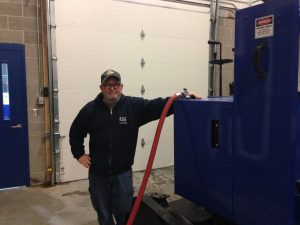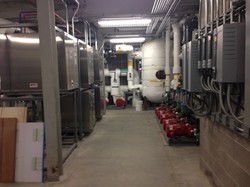According to the International Ice Hockey Federation, the number of ice rinks in the USA is growing – and that’s corresponds USA Hockey‘s membership figures too. From the 2010-11 season to 2014-15, that number went from a generic 1,800 to 2,400 – with an indoor/outdoor split of 500 outdoor rinks and 1,900 indoor rinks. USA Hockey counted 533,000 players in the 2014-15 season, a 6.5% increase in members over the same period of time.
When new ice rinks are being designed, energy efficiency should be one of the most important considerations for saving money and cutting down on the future facility’s carbon footprint. A great example of this is the single-pad, NHL-sized Keene Community Ice Arena in Keene, NH. For this new rink construction, this non-profit’s Board of Directors pulled out all the stops when considering how to make their arena as energy efficient as possible for a build that cost just under $9 million. The rink, which had its official opening on April 3, 2016, took nearly five years to realize, going from an idea to reality. And when it became evident the rink wouldn’t be ready in time for the start of the 2014-15 season, the Board of Directors decided to delay the build for another season, which gave them time to raise more money and to explore energy efficiencies for the building that would make long term sense.
ROI: the Bottom Line
At the end of the day this is also about return on investment for us. Of course, there’s a feel-good aspect to what we did, but it also helps to reinforce a sustainable bottom line,” says Dr. Tim Fisher, president of the 10-member non-profit Board of Directors of Keene ICE.
The Keene board set up an Energy Efficiency Committee comprised of the Chair, Hutch Stone (Keene ICE board and building committee member), Rich Beard (Keene ICE building committee member) and Bob King, a project donor who is passionate about energy efficiency and who, like Stone and Beard, has a son who plays hockey. According to Beard, Bob King “challenged Keene ICE to make the new rink as energy efficient as possible and he was generous with his time and resources to support that cause”.
“Everyone on the Energy Efficiency Committee was outstanding, but Bob King really shook the tree,” says Fisher. “He pushed us, telling us, ‘Never settle for good enough’ and that’s what we tried to do.”
The Energy Efficiency committee hired Resilient Buildings Group, specialists in building efficiencies who, in turn, engaged a technical expert investigated solutions, developed models and submitted the recommendations. That expert was Bill Root from GRW Engineering — whose qualifications include being LEED accredited and an ASHRAE high-performance building design certified professional. Root proposed a dozen ECMs – Energy Conservation Measures: half a dozen of those were incorporated into the final build.
“The other half a dozen items that weren’t incorporated just didn’t make sense financially at the time, with paybacks that extended beyond a 25-year time frame. But that doesn’t mean they’re not still on our radar, for future implementation,” Beard says. “We plan to revisit them in the future, including solar energy if and when it makes sense.”
Shared Facilities
From a design point of view, the 475-seat arena has a lobby, party room, community room, storage rooms and a total of eight locker rooms – two small (for officials) and six large (for teams). Their six large locker rooms are laid out in a 2+2+2 configurations with each pair sharing a set of showers/toilets/sinks and urinals.
“Shared bathroom facilities didn’t just cut down on the infrastructure costs, but cuts down on the maintenance expenses too,” says Rick Martin, Keene Ice’s operations manager. The hot water for the showers is supplied by high-efficiency propane hot water heaters; the toilets flush at less than a gallon per flush and all the locker rooms have radiant heating, “The warm floors makes it really nice for the players: they can walk around in their sock feet and it feels oh so good!” Martin says.
Heating and Cooling
Heating for the area above the bleachers is set at 45°F (7.2°C). “We lowered it from an initial high of 48°F when we first opened our doors,” Martin says. Beard says they examined different models and found that 45°F is the most efficient setting: that raising it or lowering it requires more energy.
The rink is cooled using two different refrigerants. R-410A is their primary refrigerant, a flourine-only refrigerant that doesn’t contribute to ozone depletion. Their secondary refrigerant is 40% ethylene glycol. Martin maintains the slab at 24°F (-4.4°C) which he’s been able to increase from an initial 21°F (-6.1°C) where it was when the facility first opened its doors on November 23rd, 2015.
The rink/building management system lets the Keene Ice operations team monitor and control all their heating, cooling and the ice/slab temperature in real time or remotely. The modular system and controls which includes Ice3 low temperature water source heat pumps from Emerald Environmental Technologies was designed and installed by Massachusetts-based Preferred Mechanical Services. Preferred Mechanical’s managing director, Alex Meade, says working together with people with common goals makes a big difference to a project.
“You can work towards the lowest carbon footprint possible when you’re working with people who have the same common goal,” Meade says. “Refrigeration hasn’t really changed much over the years so we ask ourselves, ‘how can we make it more efficient?’ So we find ways, like limiting the load, or with waste heat, we want to squeeze as much juice from the orange as we can and redistribute it where it makes sense. The folks at Keene ICE were willing to do that, and it worked. I’m very proud of that installation.”
Melt Pit as Cooling Tower Source
“Our melt pit doubles as a cooling tower tank, and this is really mind-blowing,” says Keene Ice’s operations manager, Rick Martin. “This means we don’t need to use city water for our cooling tower to cool down the hot glycol from the ice plant. We haven’t used city water for our cooling tower now for eight weeks, and that’s an incredible savings of water!” Martin says it also cuts down on the amount of electricity needed to run the rink and there are days when he doesn’t hear his cooling tower even run.
“The last rink I worked in had a condenser tank fed with city water only,” Martin says. “All the water that came in was either evaporated through the cooling tower or bled to the sewer to keep the total dissolved solids in range. Nothing was reused. All the snow that was scraped off the sheet was dumped in a melt pit, melted by water heated by a propane hot water tank and drained into the sewer — again nothing reused. It’s just amazing the amount of waste an ice rink can create or, like Keene Ice, the amount that can be saved.”
Other Energy Efficient FeaturesThe other energy efficient features of Keene ICE include a Low E-ceiling over the ice surface, a wirelessly controlled rink lighting system with dimmable LED fixtures, occupancy sensors controlling the lights in the spaces adjacent to the rink and a Reclaim Heating system that uses rejection heat from the refrigeration system to heat the locker rooms, lobby area, bathrooms, pro-shop, storage room and the side walk snow melting system at rinks entrance.
In addition they use a hot-water alternative for maintaining their ice called REALice, a system that removes the micro air bubbles in water without needing hot water, which is traditionally used to remove the air bubbles in the ice-making process. The resulting water doesn’t need any other chemicals or systems to maintain the ice but Martin says they pull some excess heat off of the compressor so the water “is somewhere around 55°F (12°C) when it hits the ice.”
“The two big things that were implemented was the low e-ceiling and the other was the REALice water treatment system used for the Zamboni,” says consulting engineer, Bill Root. “The REALice system is such a no brainer, I wondered why it’s not a standard device for all ice rinks.”
Their ice resurfacer is a second-hand electric Zamboni.
Energy Costs
As for the energy use, Keene ICE has now had five months of energy used which included putting the ice in and playing with the systems to find the optimal settings.
“Our sense from the operations group is our energy costs are significantly below what was expected and, in fact, budgeted,” says Fisher.
“This place is magnificent,” Martin says. “As far as community rinks goes, this is one of the best.”
Colleen O’SheaBA in Canadian Studies from the University of Regina through Athol Murray College of Notre Dame. BA (Honors) in Journalism and Communications from the University of Regina. Digital content expert. Originally a golf mom, though golf slowly killed my spirit years ago. Hockey may have saved my life.



